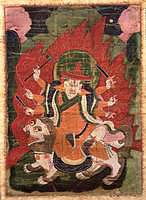
|
Avowed Protector Pehar (painting no. 232)
|

View Larger Image |
||||||||||||||
|
Deity King Pehar. King Pehar in absolute sense is an emanation of the five Buddhas and in ordinary (common) sense appears as a Deity, Protector Pehar. Here is his history: Many eons, many kalpas ago he was born as the King Damaraja of Asura coutry. At the same time another boy was born as a minister's son. They became good friends. Then they became monks, ordained by abbot Dawe ("moon light"). Damaraja's religious name was Dawe Shinu, his friend's religious name was Tunten Nagpo. Dawe Shinu became a scholar, who enjoyed teaching Dharma, his friend enjoyed meditating. One day Dawe Shinu went to visit a Hindu Temple where he met a beautiful girl named Zitan Metog Ke. Extremely strong desire arose in him toward her. They made love in the Temple. Dawe Shinu broke his vows. They were making love in the Temple for 7 days. His friend, monk Tunten Nagpo came there trying to stop them, but he could not. Dawe Shinu got angry and turned himself into a wild lion and threatened his friend, trying to kill him. Vajrapani protected Tunten Nagpo with His Vajra. Later Dawe Shinu died and he was born in hell, where his name was the Buthcher's horse and where he had suffered a lot. Then he was reborn as a human being, but he was very poor and homeless and he was wandering around. One day he met again his former friend Tunten Nagpo and they did not like each other. Then Dawe Shinu was born in the family of king Muche Tsampo and queen Lumo Tongon. His name was Vajra Kuhe Samati. Again, Tunten Nagpo was meditating in the cave and Vajra Kuhe Samati turned himself into a rat, trying to disturb his former friend. Again, Vajprapani protected Tunten Nagpo. Then Vajra Kuhe Samati (Dawe Shinu) was born as a son of Dudje Tsempo, the king of ancient demons. His name in this rebirth was Mudu Tankhar. His father had five children and he was the third son. Present King Pehar is a reincarnation of Mudu Tankhar. King Pehar has three faces, six arms and he is riding a lion. He is known as a King of Trinle, King of Action. However, when Guru Rinpoche and the Tibetan King Trisum Detsen built the Samye monastery, Guru Rinpoche invited this Deity, King Pehar, from the place, called Petahor. Guru Rinpoche gave him a wife, Mentsun Karmo, and another girlfriend. They built a place for King Pehar in the Northen side of Samye monastery. Even today there is a room called Peharchok. Guru Rinpoche invited many other Deities as well and built many temples for them around Samye. Pehar's temple is called the Turquoise Palace. His wife is Mentsun Karmo. Thus is the history of King Pehar. L. Kunga Rinpoche 7-98 PEHAR GYALPO, the Worldly Protector - King Pehar. Wrathful and fierce, Pehar, white in colour, has three faces each with three glaring eyes. The right face is red and the left blue. With six arms the three right hands hold a sword, arrow and hammer. In the left are held a stick, bow and knife. He wears a broad round red hat and rides a white (mythical) snow lion. Dressed in a long flowing orange robe augmented with various coloured layers of garments and Mongolian style felt boots he dwells within the flames of pristine awareness. "In former times at Glorious Red Rock, Acarya Padmasambhava, inviting the profound vast protector, Had bound by an oath as the entrusted steward of all Dharma Centres; To Pehar I bow." (Nyingma liturgical verse). Pehar is a worldly protector of non-Tibetan origin who was oath-bound by Guru Rinpoche in the 9th century and appointed primarily as a guardian of Samye Monastery in Tibet. There are many fascinating accounts of his early history found in both Nyingmapa and Gelugpa sources. According to some Tibetan Buddhist scholars Pehar is the leader of all Worldly Buddhist protectors. According to others he has already reached complete enlightenment and entered the ranks of the wisdom deities. The worship of Pehar has penetrated all of Tibetan society however the main upholders of the practice are predominantly the original Nyingmapas followed by the Gelugpas from the time of the great 5th Dalai Lama (1617-1682) when they became the spiritual and secular rulers of Tibet. J.Watt 7-98
|
|||||||||||||||
Photographed Image Copyright © 1998 Shelley & Donald Rubin Foundation
|
|
| |
Next Image |